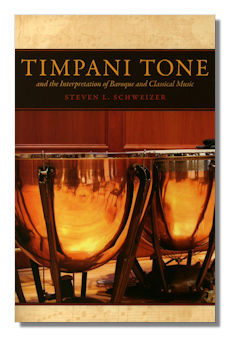
The Internet's Premier Classical Music Source
Related Links
-
Introduction
Acoustics
Ballet
Biographies
Chamber Music
Composers & Composition
Conducting
Criticism & Commentary
Discographies & CD Guides
Fiction
History
Humor
Illustrations & Photos
Instrumental
Lieder
Music Appreciation
Music Education
Music Industry
Music and the Mind
Opera
Orchestration
Reference Works
Scores
Thematic Indices
Theory & Analysis
Vocal Technique
Search Amazon
Recommended Links
Site News
 Book Review
Book Review
Timpani Tone and the Interpretation of Baroque and Classical Music

Steven L Schweizer
Oxford University Press
ISBN-10: 0195395565
ISBN-13: 9780195395563
This book covers a specific and specialized area; but one which will be illuminating for the general reader and lover of late Baroque and Classical music. Timpani Tone and the Interpretation of Baroque and Classical Music is a near-exhaustive, certainly very competent and well-produced and illustrated, study of the theory and practice of producing timpani tone in symphonic music from 1725 onwards. It's intended for timpanists, but is well-enough written to appeal also to (non-playing) listeners too.
In its 170 or so pages of substantive text, Steven L Schweizer (who has played timpani with the Topeka Symphony and Florence (South Carolina) Symphony Orchestras and is Associate Professor and Program Coordinator of the Political Science Department at Newberry College) examines the acoustics of timpani tone production and how to employ these in conferring (greater) expressivity on Baroque and Classical music.
Indeed, interpretation is at the forefront of this book's concerns. Particularly in the wide field of music of the Classical period… nearly half of the text is devoted to this area. Twenty percent of the book covers the interpretation of Baroque music; 15% is devoted to "Musical Interpretation and the Timpanist"; and nearly 20% to the technical side of timpani tone production… mallets, heads, playing styles, positions and grips; as well as the drums themselves. The latter makes fascinating reading for the novice and non-specialist audience member as well as for the aspiring timpanist; and surely for the established player who wishes to refine her/his technique.
But Schweizer has an essential theory, which is as important as the narrative contained in the text. Indeed, once which re-inforces the importance of technique. That timpani of the periods under consideration were capable of greater and subtler tone production than has hitherto been accepted. To supplement this treatise, the author examines in detail the timpani parts which any player is likely to deal with on a daily basis. He sets these examinations against current thinking in the areas of wider period performance practice.
Although there are published texts on more "neutral" aspects of timpani technique (most of which are fully acknowledged, drawn upon and, where appropriate, recommended), this is the only such currently available on tone, and – significantly – tone in the service of greater interpretative expressivity.
Timpani Tone and the Interpretation of Baroque and Classical Music is amply illustrated both with black and white photographs and extracts from scores as well as graphs… spectrographs of different sound productions, for example. Most theses and points where it's necessary are supported by meticulous notes, which themselves occupy five pages. There's an unannotated bibliography; and discography pointing to recordings of music from the B Minor Mass to Mozart's Requiem, the historical center of gravity of the book. There is a password-protected website to further expand availability of relevant supporting material.
This is a highly satisfactory book, which is both scholarly and of more general appeal. Schweizer has gathered, assembled and illustrated his material in such a way that it can be assimilated in a handful of concentrated sittings, which will be as generally enlightening on this area of musical performance as it will directly inform the professional. It seems likely that Timpani Tone and the Interpretation of Baroque and Classical Music will re-enliven the style of already competent and committed timpanists. In fact, it goes further. It throws new light on some of the wider issues which have to be understood in order to make the most of the music of the period. Recommended without hesitation.
Copyright © 2010 by Mark Sealey.



















